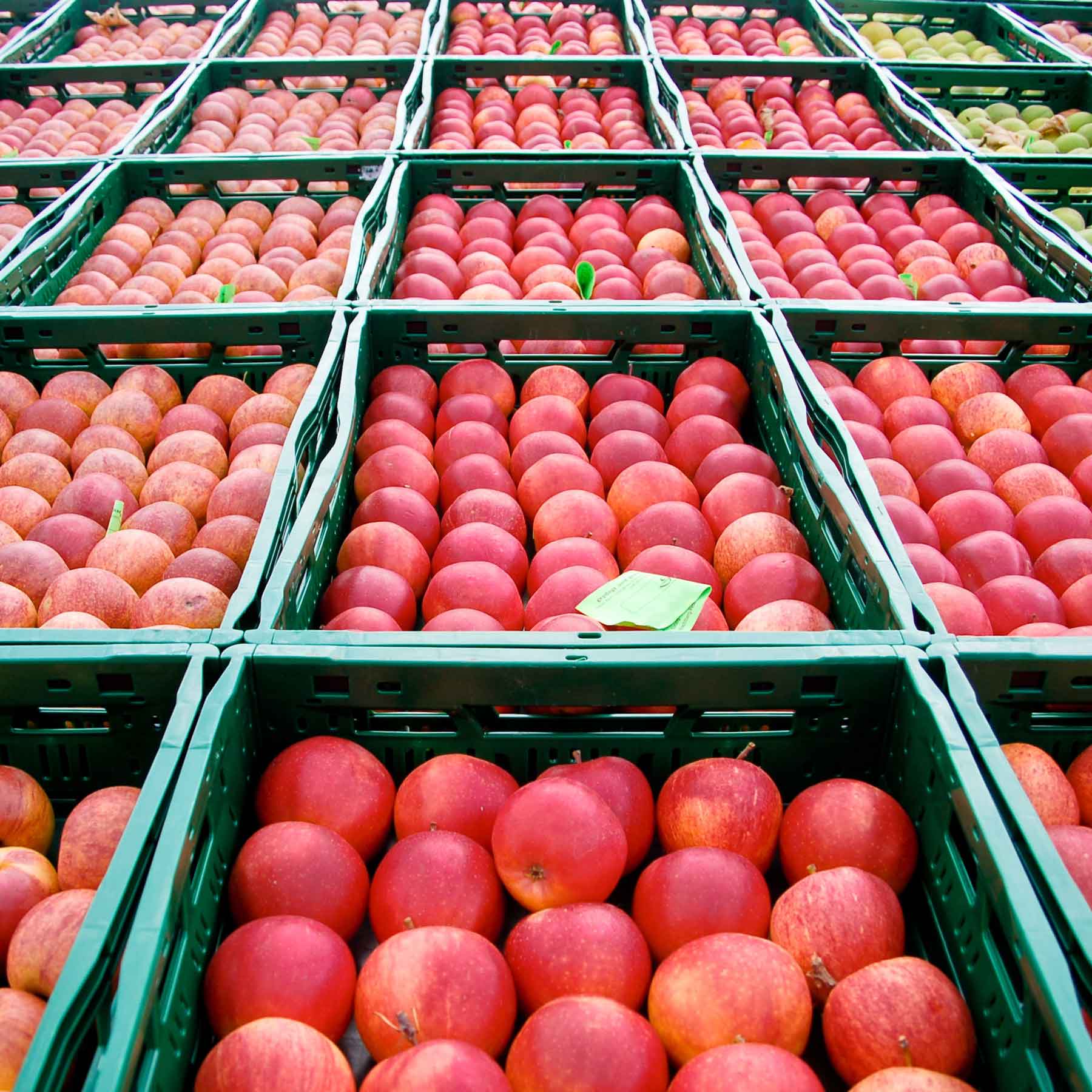
At USApple, we think of our members as superhuman, because growing and distributing a supply of fresh apples and apple products that are available year-round anywhere in the world is truly incredible.
Today, we’re celebrating not just the science, technology and strategy behind that mission—but also the people who know how to make it all function seamlessly year after year. We heard from members across the United States who work in different roles throughout the industry—from orchard to export to retail marketing—and then turned them into superhero characters who personify just what makes the apple industry exceptional.
We call them the A-Team. (They often work with the Bee Team).
Mark Boyer as Coreo
On Apple Growing
Ridgetop Orchards, Fishertown, Pa..
“An apple has to be able to survive the entire process, or the eating experience won’t be right.”
Superpower: The mastermind ensuring fruit is grown and harvested for the optimal eating experience.
Growers like Boyer orchestrate the orchard’s timeline throughout the year to ensure trees are properly cared for and pollinated, so fruit grows in a way that meets tight harvest timelines and precise operational bandwidth. After trees have had their chilling hours during the winter, they are ready to bear fruit again, but unpredictable spring weather and rapid fluctuation and temperatures can lead to bud damage. Thus, Boyer deploys frost protection measures, like large fans that bring rising warm air downward toward ground level.
Like most growers, Boyer brings in bees to help with pollination during bloom season. Bees often start in Florida during the early spring and support pollination all along the east coast, working northward as the weather warms.
Pruning the buds, ensuring that trees will not overcrop, is essential in growing flavorful, delicious fruit. Pruning also creates the best conditions for an efficient harvest. Boyer counts and cuts the buds back to 80 to100 per tree to enhance the fruit’s size, flavor and color.
To time the harvest accurately, apples are measured for sugar and starch content using fractometers and iodine tests. Harvest timelines are organized across multiple varieties and orchard blocks to optimize the eating experience, knowing they will need to be packed, stored and transported first.
Trish Taylor as Airess
On Controlled Atmosphere
Riveridge Produce Marketing, Inc., Sparta, Mich.
“Most of us don’t stop to think how buying an apple in February is made possible.”
Superpower: Controlling the gases in apple storage facilities for long-term storage and access to fresh fruit at peak ripeness year-round.
When apples are harvested, their pressure, sugar content and starches are measured to determine their expected lifespan.
There are three levels of storage control—common storage, cold storage and controlled atmosphere (CA). While common storage is a naturally cooler room or cellar, it does not have climate control. Cold storage is refrigerated but does not have control over the air composition. Apples last a very long time there, but with less control over the fruit’s continued ripening.
An apple’s storage process depends on the variety and how long it will need to be stored. Certain varieties like Gala may be more suited for controlled atmosphere storage depending on the light, water or other conditions they were grown in.
Today’s controlled atmosphere rooms are refrigerated, and the air is manipulated to push out oxygen and replace with nitrogen. The normal air we breathe is typically 70 percent nitrogen and 30 percent oxygen, but CA is close to 100 percent nitrogen. Nitrogen generators take in the air and filter out the oxygen, while carbon dioxide scrubbers also filter out carbon dioxide, a natural byproduct of respiration. Newer technologies such as this can be connected to Wi-Fi and managed via smartphone.
Dynamic CA is starting to emerge, where the balance of oxygen and nitrogen is tailored to the year’s crop. There are many exciting new developments that will continue to change how fruit is stored and what it makes possible for stakeholders across the industry.
Michelle Gabb as Halo
On Packing
Turkey Knob Apples, Timberville, Va.
Superpower: Processes protecting apples from bruising and damage as they make their way from orchard to storage to shipment.
Once apples have cooled after harvesting, they are brought into the packing house and onto the packing lines where they float along, propelled by jet streams, to be washed and sanitized without bruising each other. Processing apples are separated, and team members sort out any apples with significant defects before apples are washed, dried and waxed. The food-grade wax makes it easier for apples to glide past each other without bruising.
A defect filter camera photographs each of the apples and compares the photo to a database to assign grades, and apples continue traversing the packing line for weighing and grading. In-line scales weigh the apples as they travel along the line to help with grading, and apples are sorted into tray lines, bag lines and box lines, depending on their grade.
The highest-grade apples are placed on trays by hand, then boxed, labeled, palletized and tagged so they can be stored in preparation for efficient shipping. Bagged apples are bagged by machine according to weight, then labeled and prepared for storage or shipping. Labeling and tagging prior to storage ensure that every apple can be traced directly back to the orchard where it originated.
Craig Hinkle as Transcider
On Processing
Knouse Foods, Peach Glen, Pa.
“There are always going to be apples that aren’t destined for fresh and need to be made into something else.”
Superpower: Processing and pasteurizing apples into shelf-stable products that last for years.
From single-serving apple sauce cups to 2,000-pound containers of apple pie filling, Knouse Foods transforms fresh apples from across the region into products that can be shipped anywhere and last for years. They make many different apple-related products that are pasteurized and shelf-stable for grocery stores, hotels, restaurants, industrial customers and more.
Though the apple peeling used to be very manual, technological advances over the years have helped automate the process. Machinery delicately moves apples along the line to prevent bruising while machines core and peel 120 to130 apples per minute. Computerized cameras are trained to look for certain types of blemishes or defects. This vision technology can scan apples for defects as they progress down a conveyor belt and utilize bursts of air to knock off any deemed unsuitable for use.
Depending on the product, processing apples are brought into the plant, washed, peeled, crushed or ground, then pasteurized through a cooking process. Afterward, it is placed into a container where its shelf life can last for years, depending on the product and packaging material. Many processed apple products include more than one variety of apples; Knouse Foods balances the apple varieties in each product for the perfect mix of texture, taste, acidity and tartness to create a consistent flavor. For sliced apples or pie fillings, the varieties tend to be more uniform to promote even cooking.
Kaari Stannard & Tenley Fitzgerald as Spiral & Splash
On Sales & Marketing
Yes! Apples, Glenmont, N.Y.
“With digital marketing, we’re creating a shorter path to purchase.”
Superpower: A woman-owned consumer brand stretching the retail calendar with grower strategies and global partnerships while using digital technology to reach customers in bold new ways.
Yes! Apples Powered New York Apple Sales is a woman-owned business creating continuity and market strength across the diverse apple-growing regions of New York. President Kaari Stannard works directly with growers on strategic thinking and planning for growth of their orchards—what to grow and what to take out. She builds strong partnerships with multi-generational farmers who are the experts on the ground and can leverage their expertise, passing knowledge across generations. By bringing together growers from across the state to leverage different orchard environments that help extend the season and diversity of varieties, Stannard has also strengthened retail relationships. With partnerships that bring apples from Nova Scotia to New Zealand, she has helped create a sales strategy that spans the globe and stretches across the entire year, sustaining both retail and consumer relationships.
As consumer behaviors around grocery shopping and produce selections evolve, Tenley Fitzgerald is leading the marketing direction for Yes! Apples—the consumer-facing brand of NY Apple Sales—to create new sales opportunities.
From branding to social media, design, packaging and the e-commerce channel, Tenley is creating new ways for consumers to shop for apples and to consider how they’re choosing their varieties and brands differently, instead of just relying on in-person sampling and the familiarity of adding apples to a grocery cart. As Covid-19 encouraged more consumers to shop online, Yes! Apples is pursuing more opportunities to leverage those lowered barriers to entry.
Steve Clement as Tempo
On Import & Export
Sage Fruits, Yakima, Wash.
“We want to ensure the timing is right. The clock is always ticking on the fruit.”
Superpower: Superspeed + precision in delivering quality produce around the world.
Success in apple imports and exports depends on the ability to build relationships around the world—finding trustworthy partners and good receivers who handle the produce well and will pay for it. Steve Clement develops strategies to time when fruit should travel across the world, assesses when competition will peak or decline in international markets, and knows which varieties will perform well in a certain market.
Sage Fruit Co. works with retailers around the world to ensure they can meet their needs, follow the proper labeling and compliance requirements, and prepare for inspections and sanitation requirements that vary across different countries. Thorough quality control measures are critical to ensure products are ready for inspection, retail and consumption on the other end. All the packing and grading decisions are happening on the packing line. These strict protocols ensure that when produce is received across the world, there are no delays or disruptions to the process that could cause declines in quality, wastage or loss of revenue. Sage also depends on storage measures, like controlled atmosphere and refrigerated shipping containers, along with SmartFresh for conventional fruit to ensure peak freshness and firmness for the end consumer.








